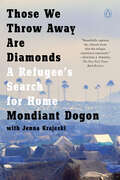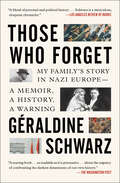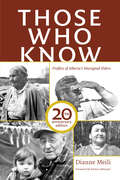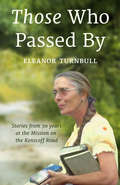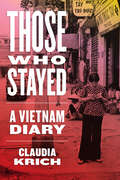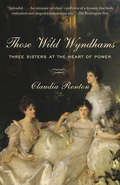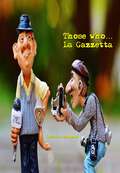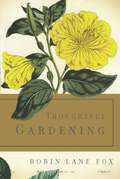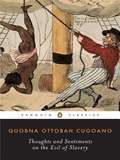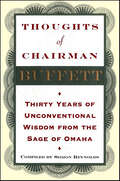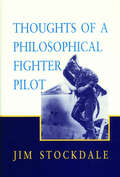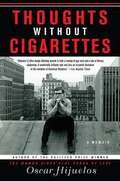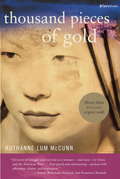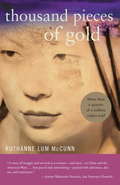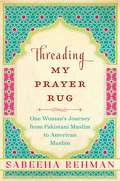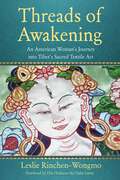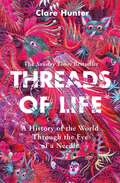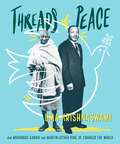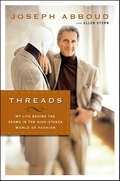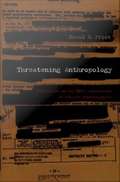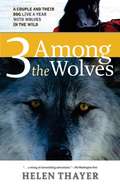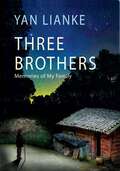- Table View
- List View
Those We Throw Away Are Diamonds: A Refugee's Search for Home
by Mondiant DogonA stunning and heartbreaking lens on the global refugee crisis, from a man who faced the very worst of humanity and survived to advocate for displaced people around the worldOne day when Mondiant Dogon, a Bagogwe Tutsi born in the Democratic Republic of Congo, was only three years old, his father&’s lifelong friend, a Hutu man, came to their home with a machete in his hand and warned the family they were to be killed within hours. Dogon&’s family fled into the forest, initiating a long and dangerous journey into Rwanda. They made their way to the first of several UN tent cities in which they would spend decades. But their search for a safe haven had just begun.Hideous violence stalked them in the camps. Even though Rwanda famously has a former refugee for a president in Paul Kagame, refugees in that country face enormous prejudice and acute want. For much of his life, Dogon and his family ate barely enough to keep themselves from starving. He fled back to Congo in search of the better life that had been lost, but there he was imprisoned and left without any option but to become a child soldier.For most refugees, the camp starts as an oasis but soon becomes quicksand, impossible to leave. Yet Dogon managed to be one of the few refugees he knew to go to college. Though he hid his status from his fellow students out of shame, eventually he would emerge as an advocate for his people.Rarely do refugees get to tell their own stories. We see them only for a moment, if at all, in flight: Syrians winding through the desert; children searching a Greek shore for their parents; families gathered at the southern border of the United States. But through his writing, Dogon took control of his own narrative and spoke up for forever refugees everywhere.As Dogon once wrote in a poem, &“Those we throw away are diamonds.&”
Those Who Forget: My Family's Story in Nazi Europe – A Memoir, A History, A Warning
by Geraldine SchwarzThose Who Forget, published to international awards and acclaim, is journalist Géraldine Schwarz&’s riveting account of her German and French grandparents&’ lives during World War II, an in-depth history of Europe&’s post-war reckoning with fascism, and an urgent appeal to remember as a defense against today&’s rise of far-right nationalism. During World War II, Géraldine Schwarz&’s German grandparents were neither heroes nor villains; they were merely Mitlaüfer—those who followed the current. Once the war ended, they wanted to bury the past under the wreckage of the Third Reich. Decades later, while delving through filing cabinets in the basement of their apartment building in Mannheim, Schwarz discovers that in 1938, her paternal grandfather Karl took advantage of Nazi policies to buy a business from a Jewish family for a low price. She finds letters from the only survivor of this family (all the others perished in Auschwitz), demanding reparations. But Karl Schwarz refused to acknowledge his responsibility. Géraldine starts to question the past: How guilty were her grandparents? What makes us complicit? On her mother&’s side, she investigates the role of her French grandfather, a policeman in Vichy. Weaving together the threads of three generations of her family story with Europe&’s process of post-war reckoning, Schwarz explores how millions were seduced by ideology, overcome by a fog of denial after the war, and, in Germany at least, eventually managed to transform collective guilt into democratic responsibility. She asks: How can nations learn from history? And she observes that countries that avoid confronting the past are especially vulnerable to extremism. Searing and unforgettable, Those Who Forget is a riveting memoir, an illuminating history, and an urgent call for remembering.
Those Who Know: 20th Anniversary Edition
by Dianne Meili"The elders in Those Who Know have devoted their lives to preserving the wisdom and spirituality of their ancestors. Despite insult and oppression, they have maintained sometimes forbidden practices for the betterment of not just their people, but all humankind. First published in 1991, Dianne Meili’s book remains an essential portrait of men and women who have lived on the trapline, in the army, in a camp on the move, in jail, in residential schools, and on the reserve, all the while counselling, praying, fasting, healing, and helping to birth further generations. In this 20th anniversary edition of Those Who Know, Meili supplements her original text with new profiles and interviews that further the collective story of these elders as they guide us to a necessary future, one that values Mother Earth and the importance of community above all else."
Those Who Passed By
by Laura Brown Eleanor TurnbullIn Those Who Passed By, veteran missionary Eleanor Turnbull traces the story of Haiti’s development by what happens along the Kenscoff Road and those who travel its bumps and curves.Throughout her nearly 70 years working in development and rural medical care, Eleanor met countless men and women who were just “passing by.” She soon learned that many of them had been “sent” for a greater purpose. Some came for research, others to find themselves; a wise few sought to widen their worldview. Each of them left an indelible mark on Haiti and her people. These are their stories.
Those Who Stayed: A Vietnam Diary
by Claudia KrichAn American Eyewitness in Vietnam at the End of War and Beginning of Peace By the end of the Vietnam War in April 1975, almost all Americans and thousands of terrified Vietnamese had left Saigon, fearing the bloodbath predicted by many if the Communists took over. But Claudia Krich and a few other humanitarian aid volunteers chose not to leave. They had no weapons, no cement barriers, no bomb shelter, and no safety, but they were determined to remain in Vietnam to see what happened next.Those Who Stayed is Claudia Krich&’s personal firsthand account of the collapse of the South Vietnamese government and the beginning of the new Provisional Revolutionary Government. Her vivid impressions of those intense, historic days emerge primarily from her journal, capturing the uncertainty, fear, and excitement as the North Vietnamese soldiers arrived. She intertwines personal, sometimes heartbreaking episodes with major historic events. Several short pieces by others with unusual firsthand knowledge enliven and contextualize the book. Fascinating and unique, engaging and entertaining, Those Who Stayed is the extraordinary story of an adventurous young woman in the right place at the right time to chronicle a pivotal moment in history.
Those Wild Wyndhams: Three Sisters at the Heart of Power
by Claudia RentonThe three dazzlingly beautiful, wildly rich Wyndham sisters, part of the four hundred families that made up Britain's ruling class, at the center of cultural and political life in late-Victorian/Edwardian Britain. Here are their complex, idiosyncratic lives; their opulent, privileged world; their romantic, roiling age.They were confidantes to British prime ministers, poets, writers, and artists, their lives entwined with the most celebrated and scandalous figures of the day, from Oscar Wilde to Henry James. They were the lovers of great men--or men of great prominence...Mary Wyndham, wilder than her wild brothers; lover of Wilfrid Blunt, confidante of Prime Minister Arthur Balfour (the Balfour Declaration); married to Hugo, Lord Elcho; later the Countess of Wemyss...Madeline Adeane, the quietest and happiest of the three...and Pamela, spoiled, beautiful, of the three, possesser of the true talent, wife of the Foreign Secretary Edward Grey (later Viscount Grey), who took Britain into the First World War. They lived in a world of luxurious excess, a world of splendor at 44 Belgrave Square, and later at the even more vast Clouds, the exquisite Wiltshire house on 4,000 acres, the "house of the age," designed, in 1876, by the visionary architect, Philip Webb; the model for Henry James's The Spoils of Poynton. They were bred with the pride of the Plantagenets and raised with a fierce belief that their family was exceptional. They avoided the norm at all costs and led the way to a blending of aristocracy and art. Their group came to be called The Souls, whose members from 1885 to the 1920s included the most distinguished politicians, artists, and thinkers of their time. In Those Wild Wyndhams, Claudia Renton gives us a dazzling portrait of one of England's grandest, noblest families. Renton captures, with nuance and depth, their complex wrangling between head and heart, and the tragedy at the center of all their lives as the privilege and bliss of the Victorian age gave way to the Edwardian era, the Great War, and the passing of an opulent world.
Those who… La Gazzetta
by Claudio CalzoniFor years the Edizioni Hogwords have been one of the reference points of the culture of the territory of the city of the Cavalry and of the Turin area and regularly publish novels and collections of poems by many subalpine authors. Particular paths have opened up around this activity, such as the organization of fun and engaging "dinners with crime" in restaurants and clubs around Piedmont and the publication of a magazine on the network called "La Gazzetta di Hogwords". This book is a miscellany of the interviews conducted by the Director.
Though Bombs May Fall: The Extraordinary Story of George Rue, Missionary Doctor to Korea
by Penny Young Sook Kim Charles Mills Richard A. SchaeferAn inspirational story of tenacity and self-sacrifice. Though Bombs May Fall is the extraordinary story of George Henry Rue, a Seventh-day Adventist missionary doctor who left a lucrative medical practice in the U.S. to serve the Korean people during the war years. It is a story that takes you into the heart of a beautiful land during its darkest days, revealing the lives of many determined individuals who wrenched success from tragedy. As you read about Dr. Rue's commitment to serve the people he loved while landmines, bombs, theft, and devastation repeatedly threatened his life, your own faith will deepen. The amazing witness of Dr. Rue inspires us all to stand strong for a God more powerful than bombs, armies, or ideologies.
Thoughtful Gardening
by Robin Lane FoxIn Thoughtful Gardening, award-winning historian and Financial Times gardening columnist Robin Lane Fox takes readers on a delightful journey through each season of the gardening year. From fending off vine-weevils to visiting Yves Saint Laurent’s private gardens in Marrakech, Fox imbues each of his musings with grace, sophistication, and charm. Essential reading for anyone planting a new garden or taking stock of one after several years, Thoughtful Gardening offers expert advice and a touching reminder of the power of art and literature to deepen what we see and experience in nature. Combining a vast understanding of horticulture with witty and stylish storytelling, these vignettes form--season by season--a rich reflection on the lessons, challenges, and joys of life with a green thumb.
Thoughts and Sentiments on the Evil of Slavery
by Quobna Ottobah Cugoano Vincent CarrettaBorn in present-day Ghana, Quobna Ottobah Cugoano was kidnapped at the age of thirteen and sold into slavery by his fellow Africans in 1770; he worked in the brutal plantation chain gangs of the West Indies before being freed in England. His Thoughts and Sentiments on the Evil of Slavery is the most direct criticism of slavery by a writer of African descent. Cugoano refutes pro-slavery arguments of the day, including slavery's supposed divine sanction; the belief that Africans gladly sold their own families into slavery; that Africans were especially suited to its rigors; and that West Indian slaves led better lives than European serfs. Exploiting his dual identity as both an African and a British citizen, Cugoano daringly asserted that all those under slavery's yoke had a moral obligation to rebel, while at the same time he appealed to white England's better self.
Thoughts of Chairman Buffett: Thirty Years of Unconventional Wisdom from the Sage of Omaha
by Siimon Reynolds"There's something about smart people explaining ideas to an orangutan that makes their decision making better."—Warren BuffettHe's an American icon, the world's most famous and most successful investor every financial move is widely reported and copied, his every utterance scanned for meaning. The secret of his success? Let Buffett tell you. He has a few thoughts on the matter.Thoughts of Chairman Buffett is pure, unadulterated Buffett: a collection of his wittiest, wisest, and most quotable quotes. Compiled by Siimon Reynolds from decades of Buffetts speeches, writings, and interviews, they include gems on such subjects as . . . Hiring"Somebody once said that in looking for people to hire, you look for three qualities: integrity, intelligence, and energy. And if they don't have the first, the other two will kill you.How to Get Wealthy"I will tell you the secret of getting rich on Wall Street. You try to be greedy when others are fearful, and you try to be very fearful when others are greedy."This is Buffett at his best: pithy, funny, unforgettable. These pearls of wisdom will make you laugh-and think. They'll give you sound advice and teach you truths about business and life.Thoughts of Chairman Buffett offers a lifetime of wisdom at your fingertips. Once you enter the world according to Buffett, you'll never see things in quite the same way again. Siimon Reynolds is a writer and advertising executive living in Australia. A longtime fan of Warren Buffett, Reynolds collected these quotations from a variety of sources, added the headings, and arranged their order of presentation for this volume. At the end of the book you will find Mr. Reynolds's interpretation of Buffett's basic rules of investing.Show MoreShow Less
Thoughts of a Philosophical Fighter Pilot
by James B. StockdaleThoughts on issues of character, leadership, integrity, personal and public virtue, and ethics, the selections in this volume converge around the central theme of how man can rise with dignity to prevail in the face of adversity—lessons just as valid for the challenges of present-day life as they were for the author's Vietnam experience.
Thoughts without Cigarettes
by Oscar HijuelosA beloved Pulitzer Prize-winning novelist turns his pen to the real people and places that have influenced his life and literature. A comprehensive look into the mind of a writer.Born in Manhattan's Morningside Heights to Cuban immigrants in 1951, Oscar Hijuelos introduces readers to the colorful circumstances of his upbringing. The son of a Cuban hotel worker and exuberant poetry-writing mother, his story, played out against the backdrop of a working-class neighborhood, takes on an even richer dimension when his relationship with his family and culture changes forever. During a sojourn with his mother in pre-Castro Cuba, he catches a disease that sends him into a Dickensian home for terminally ill children. The yearlong stay estranges him from the very language and people he had so loved.With a cast of characters whose stories are both funny and tragic, Thoughts Without Cigarettes follows Hijuelos's subsequent quest for his true identity -- a mystery whose resolution he eventually discovers hidden away in the trappings of his fiction, and which finds its most glorious expression in his best-known book,The Mambo Kings Play Songs of Love. Illuminating the most dazzling scenes from his novels, Thoughts Without Cigarettes reveals the true stories and indelible memories that shaped a literary genius.
Thousand Pieces of Gold
by Ruthanne Lum MccunnLalu Nathoy's father called his thirteen-year-old daughter his treasure, his "thousand pieces of gold," yet when famine strikes northern China in 1871, he is forced to sell her. Polly, as Lalu is later called, is sold to a brothel, sold again to a slave merchant bound for America, auctioned to a saloonkeeper, and offered as a prize in a poker game. This biographical novel is the extraordinary story of one woman's fight for independence and dignity in the American West.From the Trade Paperback edition.
Thousand Pieces of Gold
by Ruthanne Lum MccunnLalu Nathoy's father called his thirteen-year-old daughter his treasure, his "thousand pieces of gold," yet when famine strikes northern China in 1871, he is forced to sell her. Polly, as Lalu is later called, is sold to a brothel, sold again to a slave merchant bound for America, auctioned to a saloonkeeper, and offered as a prize in a poker game. This biographical novel is the extraordinary story of one woman's fight for independence and dignity in the American West.
Threading My Prayer Rug: One Woman's Journey from Pakistani Muslim to American Muslim
by Sabeeha RehmanONE OF BOOKLIST'S TOP TEN RELIGION AND SPIRITUALITY BOOKS OF 2016ONE OF BOOKLIST'S TOP TEN DIVERSE NONFICTION BOOKS OF 2017Honorable Mention in the 2017 San Francisco Book Festival Awards, Spiritual CategoryThis enthralling story of the making of an American is also a timely meditation on being Muslim in America today.Threading My Prayer Rug is a richly textured reflection on what it is to be a Muslim in America today. It is also the luminous story of many journeys: from Pakistan to the United States in an arranged marriage that becomes a love match lasting forty years; from secular Muslim in an Islamic society to devout Muslim in a society ignorant of Islam, and from liberal to conservative to American Muslim; from student to bride and mother; and from an immigrant intending to stay two years to an American citizen, business executive, grandmother, and tireless advocate for interfaith understanding.Beginning with a sweetly funny, moving account of her arranged marriage, the author undercuts stereotypes and offers the refreshing view of an American life through Muslim eyes. In chapters leavened with humor, hope, and insight, she recounts an immigrant’s daily struggles balancing assimilation with preserving heritage, overcoming religious barriers from within and distortions of Islam from without, and confronting issues of raising her children as Muslims-while they lobby for a Christmas tree! Sabeeha Rehman was doing interfaith work for Imam Feisal Abdul Rauf, the driving force behind the Muslim community center at Ground Zero, when the backlash began. She discusses what that experience revealed about American society.
Threads of Awakening: An American Woman's Journey into Tibet's Sacred Textile Art
by Leslie Rinchen-WongmoWhat if you set out to travel the world and got sidetracked in a Himalayan sewing workshop? What if that sidetrack turned out to be your life’s path—your way home? Part art book, part memoir, part spiritual travelogue, Threads of Awakening is a delightful and inspiring blend of adventure and introspection. Leslie Rinchen-Wongmo shares her experience as a California woman traveling to the seat of the Tibetan government-in-exile in India to manage an economic development fund, only to wind up sewing pictures of Buddha instead. Through her remarkable journey, she discovered that a path is made by walking it—and that some of the best paths are made by walking off course. For more than 500 years, Tibetans have been creating sacred images from pieces of silk. Much rarer than paintings and sculptures, these stitched fabric thangkas are among Tibet's finest artworks. Leslie studied this little-known textile art with two of its brightest living masters and let herself discover where curiosity and devotion can lead. In this book, she reveals the unique stitches of an ancient needlework tradition, introduces the Buddhist deities it depicts, and shares insights into the compassion, interdependence, and possibility they embody. Includes 49 full-color photos and a foreword by the Dalai Lama.
Threads of Life: A History of the World Through the Eye of a Needle
by Clare Hunter**SUNDAY TIMES BESTSELLER** **RADIO 4 BOOK OF THE WEEK** **WATERSTONES SCOTTISH BOOK OF THE MONTH**'An astonishing feat'Christina Patterson, Sunday Times'An inspiring and moving sideways look at history'Eithne Farry, Sunday Express An eloquent blend of history and memoir, Threads of Life is an evocative and moving book about the need we all have to tell our story.From political propaganda in medieval France to secret treason in Tudor England, from the mothers of the desaparecidos in Argentina to First World War soldiers with PTSD, from a POW camp in Singapore to a family attic in Scotland, Threads of Life is a global chronicle of identity, protest, memory and politics. Banner-maker, community textile artist and textile curator Clare Hunter chronicles the stories of the men and women, over centuries and across continents, who have used the language of sewing to make their voices heard, even in the most desperate of circumstances.'A beautifully considered book... Clare Hunter has managed to mix the personal with the political with moving results.' TRACY CHEVALIER
Threads of Life: A History of the World Through the Eye of a Needle
by Clare Hunter**SUNDAY TIMES BESTSELLER** **RADIO 4 BOOK OF THE WEEK** **WATERSTONES SCOTTISH BOOK OF THE MONTH**'An astonishing feat'Christina Patterson, Sunday Times'An inspiring and moving sideways look at history'Eithne Farry, Sunday ExpressAn eloquent blend of history and memoir, Threads of Life is an evocative and moving book about the need we all have to tell our story.From political propaganda in medieval France to secret treason in Tudor England, from the mothers of the desaparecidos in Argentina to First World War soldiers with PTSD, from a POW camp in Singapore to a family attic in Scotland, Threads of Life is a global chronicle of identity, protest, memory and politics. Banner-maker, community textile artist and textile curator Clare Hunter chronicles the stories of the men and women, over centuries and across continents, who have used the language of sewing to make their voices heard, even in the most desperate of circumstances.'A beautifully considered book... Clare Hunter has managed to mix the personal with the political with moving results.' TRACY CHEVALIER
Threads of Peace: How Mohandas Gandhi and Martin Luther King Jr. Changed the World
by Uma KrishnaswamiMahatma Gandhi and Reverend Martin Luther King Jr. both shook, and changed, the world, in their quest for peace among all people, but what threads connected these great activists together in their shared goal of social revolution?A lawyer and activist, tiny of stature with giant ideas, in British-ruled India at the beginning of the 20th century. A minister from Georgia with a thunderous voice and hopes for peace at the height of the civil rights movement in America. Born more than a half-century apart, with seemingly little in common except one shared wish, both would go on to be icons of peaceful resistance and human decency. Both preached love for all human beings, regardless of race or religion. Both believed that freedom and justice were won by not one, but many. Both met their ends in the most unpeaceful of ways—assassination. But what led them down the path of peace? How did their experiences parallel...and diverge? Threads of Peace keenly examines and celebrates these extraordinary activists&’ lives, the threads that connect them, and the threads of peace they laid throughout the world, for us to pick up, and weave together.
Threads: My Life Behind the Seams in the High-Stakes World of Fashion
by Ellen Stern Joseph AbboudDesigners are great white sharks, and we roam the waters ourselves. We often pretend to like and admire each other, but sometimes we don't even bother to fake it. The fashion industry is as hardworking, incestuous, and political as any other, and it's virtually impossible, given the size of designers' egos, to sincerely wish someone else well, because behind every false tribute is 'It should have been me.'So writes Joseph Abboud, who fell in love with style at five. There in the dark of the movie house, he wasn't just some Lebanese kid with a babysitter. He was the hero, in tweeds and pocket squares. That's where he learned that clothes represented a better life—a life he wanted, and would grab, for himself. From his blue-collar childhood in Boston's South End to his spread-collar success as one of America's top designers, he has forged a remarkable path through the unglamorous business of making people look glamorous.He transformed American menswear by replacing the traditional stiff-shouldered silhouette with a grown-up European sensuality. He was the first designer to win the coveted CFDA award as Best Menswear Designer two years in a row and the first designer to throw out the opening pitch at Fenway Park. He's been jilted by Naomi Campbell (who didn't show up on the runway for his first women's fashion show) and questioned by the FBI (who did show up in his office right after September 11 because he fit the profile). He's soared and sunk more than a few times—and lived to tell the tales.Threads is his off-the-record take on fashion, from the inside out. With breezy irreverence, he looks at guys and taste, divas and deviousness, fabric and texture, and all those ties. He takes us to the luxe bastion of Louis Boston, where he came of age and learned the trade, and to the seductive domain of Polo Ralph Lauren, where he became associate director of menswear design. He reveals the mystique of department-store politics, what's what at the sample sale, and who copies whom. He explains the process of making great clothes, from conception and sketch to manufacturing and marketing.Whether he's traveling by daredevil horse, plunging plane, Paris Métro, or cross-country limo, Abboud is an illuminating guide to a complex world.
Threatening Anthropology: McCarthyism and the FBI's Surveillance of Activist Antrhopologists
by David H. PriceA vital reminder of the importance of academic freedom, Threatening Anthropology offers a meticulously detailed account of how U. S. Cold War surveillance damaged the field of anthropology. David H. Price reveals how dozens of activist anthropologists were publicly and privately persecuted during the Red Scares of the 1940s and 1950s. He shows that it was not Communist Party membership or Marxist beliefs that attracted the most intense scrutiny from the fbi and congressional committees but rather social activism, particularly for racial justice. Demonstrating that the fbi's focus on anthropologists lessened as activist work and Marxist analysis in the field tapered off, Price argues that the impact of McCarthyism on anthropology extended far beyond the lives of those who lost their jobs. Its messages of fear and censorship had a pervasive chilling effect on anthropological investigation. As critiques that might attract government attention were abandoned, scholarship was curtailed. Price draws on extensive archival research including correspondence, oral histories, published sources, court hearings, and more than 30,000 pages of fbi and government memorandums released to him under the Freedom of Information Act. He describes government monitoring of activism and leftist thought on college campuses, the surveillance of specific anthropologists, and the disturbing failure of the academic community--including the American Anthropological Association--to challenge the witch hunts. Today the "war on terror" is invoked to license the government's renewed monitoring of academic work, and it is increasingly difficult for researchers to access government documents, as Price reveals in the appendix describing his wrangling with Freedom of Information Act requests. A disquieting chronicle of censorship and its consequences in the past, Threatening Anthropology is an impassioned cautionary tale for the present.
Three Among the Wolves: A Couple and Their Dog Live a Year with Wolves in the Wild
by Helen ThayerHelen and Bill Thayer, accompanied by their part-wolf, mostly Husky dog, Charlie, set out to live among wild wolf packs -- first in the Canadian Yukon and then in the Arctic. When they set up camp within 100 feet of a wolf den, they were greeted with apprehension. But they establish trust over time because the wolves accept Charlie as the alpha male of the newly arrived "pack." Readers travel with the Thayers as they learn about wolf family structure, view the intricacies of the hunt, the wolves' finely honed survival skills, and playfulness.
Three Book Sebald Set: The Emigrants, The Rings of Saturn, and Vertigo
by Michael Hulse W. G. SebaldThe masterworks of W. G. Sebald, now in gorgeous new covers by the famed designer Peter Mendelsund New Directions is delighted to announce beautiful new editions of these three classic Sebald novels, including his two greatest works, The Emigrants and The Rings of Saturn. All three novels are distinguished by their translations, every line of which Sebald himself made pitch-perfect, slaving to carry into English all his essential elements: the shadows, the lambent fallings-back, nineteenth-century Germanic undertones, tragic elegiac notes, and his unique, quiet wit.
Three Brothers: Memories of My Family
by Yan LiankeFrom the Franz Kafka Prize–winning author. “Full of love, sorrow, and tenderness . . . a deeply heartfelt account of his family in the 1960s and 70s.” —Xiaolu Guo, award-winning author of Nine ContinentsWith lyricism and deep emotion, Yan Lianke chronicles the extraordinary lives of his father and uncles, as well as his own during the Cultural Revolution. Living in a remote village, Yan’s parents are so poor that they can only afford to use wheat flour on New Year and festival days, and while Yan dreams of fried scallion buns, and even steals from his father to buy sesame seed cakes. He yearns to leave the village, however he can, and soon novels become an escape. He resolves to become a writer himself after reading on the back of a novel that its author was given leave to remain in the city of Harbin after publishing her book. In the evenings, after finishing back-breaking shifts hauling stones at a cement factory, sometimes sixteen hours long, he sets to work writing. He is ultimately delivered from the drudgery and danger of manual labor by a career in the Army, but he is filled with regrets as he recalls these years of scarcity, turmoil, and poverty.A philosophical portrait of grief, death, home, and fate that gleams with Yan’s quick wit and gift for imagery, Three Brothers is a personal portrait of a politically devastating period, and a celebration of the power of the family to hold together even in the harshest circumstances.“This engaging book asks readers to consider the nature of life and death, city versus country, and the impact generations can have on each other.” —Winnipeg Free Press
